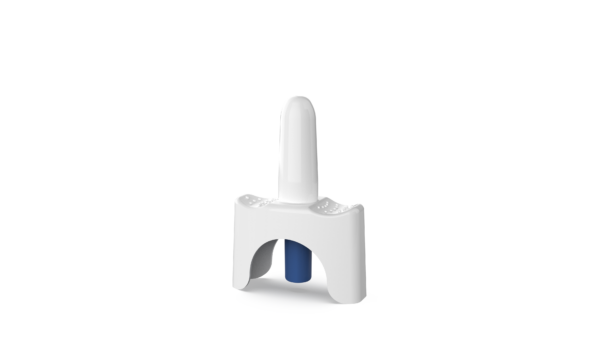
Decades of research can go into the development of a single drug– taking a compound through research and development, testing, and eventually federal approval. Beyond the chemical makeup of these drugs, how they are administered is a key consideration. One recent advancement is intranasal drug delivery, which offers a number of benefits over traditional methods like oral tablets or injections. This non-invasive approach has gained significant attention in recent years for its effectiveness, ease of administration, and rapid absorption into the bloodstream.
What is Intranasal Drug Delivery?
Intranasal drug delivery is an alternative to systemic drug administration where the drug is delivered into the nasal cavity, which houses the endings of nerves that connect to the olfactory bulb. Chemicals traveling through or alongside these fibers can bypass the blood-brain barrier (BBB) and have direct access to central nervous system (CNS). The nasal cavity is the only accessible surface on the body that has direct access to the CNS.
Benefits of Intranasal Drug Delivery
Enhanced Bioavailability
This delivery method offers a higher bioavailability – how much of a drug’s active compounds that reach its intended biological destination – compared to oral medications, which often undergo extensive metabolism in the liver before reaching their target sites. By avoiding first-pass metabolism via the gastrointestinal tract, intranasal drugs can achieve more rapid and efficient therapeutic effects.
Rapid Onset of Action
The nasal cavity is richly supplied with blood vessels and has a large surface area, which facilitates rapid absorption of drugs. This allows for faster onset of action, making intranasal delivery an attractive option in emergencies or situations that require immediate relief. Medications for conditions like allergic rhinitis, migraine attacks, or acute pain can quickly alleviate symptoms, improving patient comfort and quality of life.
Non-Invasive and Patient-Friendly
Intranasal drug delivery eliminates the need for injections, making it a more comfortable and convenient option for patients. Many individuals, particularly children and those with a fear of needles, experience anxiety or distress during traditional injection-based treatments. The non-invasive nature of intranasal administration reduces these concerns, improving patient compliance and overall treatment satisfaction.
Improved CNS Delivery
The unique anatomy of the nasal cavity allows for direct access to the CNS. This feature is particularly valuable in neurology and psychiatry, where targeted drug delivery to the brain is often challenging. Intranasal delivery has shown promise in delivering medications for conditions such as migraine and psychiatric disorders, bypassing the blood-brain barrier and enhancing therapeutic efficacy.
Suitable for Poorly Absorbed Drugs
Certain drugs exhibit low oral bioavailability due to poor absorption or degradation in the gastrointestinal tract. Intranasal drug delivery offers an alternative route that can bypass these limitations, providing a more efficient means of drug administration. This method has been successfully employed for medications such as peptide and protein-based drugs, hormones, and antiviral agents.
Improved Pediatric and Geriatric Care
Administering medications to young children or elderly patients can be challenging due to difficulties in swallowing or decreased gastric motility. Intranasal drug delivery presents a viable option for these populations, offering a non-invasive alternative that ensures drug absorption and therapeutic benefits. It simplifies dosage administration and reduces the risk of aspiration or choking, enhancing safety and medication compliance.
Localized Drug Delivery
In addition to systemic effects, intranasal drug delivery allows for targeted delivery to the nasal and sinus regions. This advantage is particularly useful in treating conditions such as allergic rhinitis, nasal congestion, sinusitis, and local infections. By directly targeting the affected area, higher drug concentrations can be achieved, resulting in improved therapeutic outcomes.
Vaccine Administration Alternative
Intranasal drug delivery also has shown to be quite effective as an alternative method for administering vaccines, from both a physiological and psychological perspective. The nasal cavity often is the initial point of entry to the body for harmful pathogens. Vaccines delivered intranasally can induce local immunity, boosting protection against possible illnesses like respiratory viruses. Additionally, as referenced earlier, intranasal drug delivery is a non-invasive approach compared to intravenous delivery methods. This can assuage fears certain individuals may have of needles, making them more receptive to getting a vaccine.
Potential for Future Medical Uses
With its enhanced bioavailability, rapid onset of action, non-invasiveness, and ability for direct CNS delivery, intranasal drug delivery has the potential to significantly impact treatment approaches in numerous fields. Further research and development in drug formulas and nasal drug delivery devices will continue to expand the possibilities of this promising route, ultimately benefiting patients worldwide with more efficient and patient-friendly drug therapies.

Silgan Dispensing’s Monodose Nasal System
The Monodose Nasal Spray is a primeless, ready-to-use device that can be used with one hand from any direction, a benefit of its 360-degree delivery capability. The solution also is optimized for bioequivalence to help brands expedite product commercialization.
Monodose makes treatment easier without the need for medical training with its quick intranasal application. It allows for rapid distribution directly to the pain source, reducing the side effects when compared to oral or injection alternatives. Developed with excellent ergonomics, this fine mist sprayer is intuitive and reliable for patients. Learn more here.
